TL;DR
-
Remote charges a flat $599/month per employee for its EOR service—but that fee only covers basic employment, payroll, and compliance.
-
Contractor payments cost $29/month, with misclassification risk falling on the client and not Remote.
-
Add-ons like visa support, supplemental benefits, and global payroll are not included in base pricing and often require custom quotes.
-
Remote’s flat pricing is consistent across countries, but benefit obligations and FX fees vary, making total cost harder to predict.
-
Remote HRIS lacks advanced features. Further, integrations and analytics often require paid upgrades.
-
Support is ticket-based and non-dedicated, which may not suit companies needing urgent, localized help.
-
Compared to platforms like Rivermate (€299/month), Remote’s model may feel rigid for companies hiring in multiple countries or needing white-glove legal guidance.
Remote EOR Pricing Unpacked: Flat Fees, Hidden Costs & EOR Comparisons
Understanding how much you’ll actually pay for a global employment platform like Remote isn’t always straightforward. On the surface, Remote advertises a flat monthly rate for its employer of record (EOR) services—but the true cost can vary significantly depending on your hiring model, regions of operation, and whether you need support for contractors, payroll, or benefits administration.

Caption: Remote advertises a flat monthly rate for its offerings, but true cost can vary
For finance leaders, HR teams, and founders building global teams, pricing transparency isn’t just a nice-to-have—it’s essential for budgeting, compliance, and risk management. With multiple vendors promising “all-in-one” workforce solutions, it’s easy to underestimate the cost implications of country-specific fees, onboarding complexity, or a-la-carte services.
Whether you're hiring a full-time engineer in Germany or onboarding contractors across LATAM, this article will help you evaluate the total cost of ownership, spot hidden fees, and make the right call for your global hiring strategy.
What is Remote's pricing structure?
Remote offers a tiered pricing model built around its core Employer of Record (EOR) service, with additional options for global payroll, contractor management, and HRIS tools. Its flagship offering—the EOR flat rate plan—positions itself as a simple, transparent solution for full-time employment in countries where Remote owns legal entities.
As of July 2025, here’s how Remote’s pricing is structured:
Employer of record (EOR) pricing
Remote charges $599 per employee per month for its standard EOR service. This flat monthly fee includes:
-
Localized employment contracts
-
Payroll setup and processing
-
Tax and social contribution filings
-
Compliance with local labor laws
-
Onboarding and offboarding management
-
Basic benefits administration
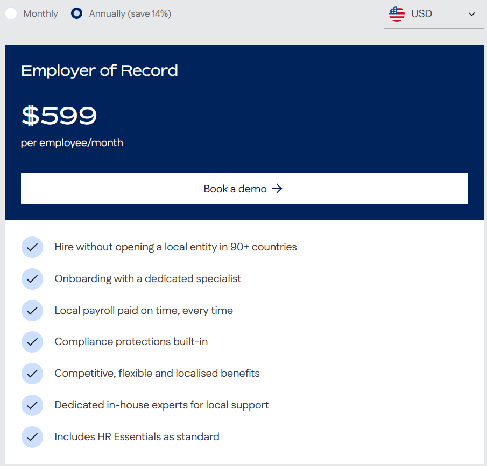
Caption: Remote charges $599 per employee/month when charged annually
Remote’s pricing is the same across all countries where it operates its own entities, which simplifies cost forecasting—but the flat rate may not reflect actual total cost in more complex regions where benefits or compliance requirements vary.
2. Contractor management pricing
Remote also supports contractor payments in over 180 countries. For this service, pricing is $29 per contractor per month. Further, there is also a contractor management plus plan with additional features. This includes:
-
Onboarding and document collection
-
Contract templates
-
Payment in local currency
-
Tax document generation (e.g., 1099 forms)
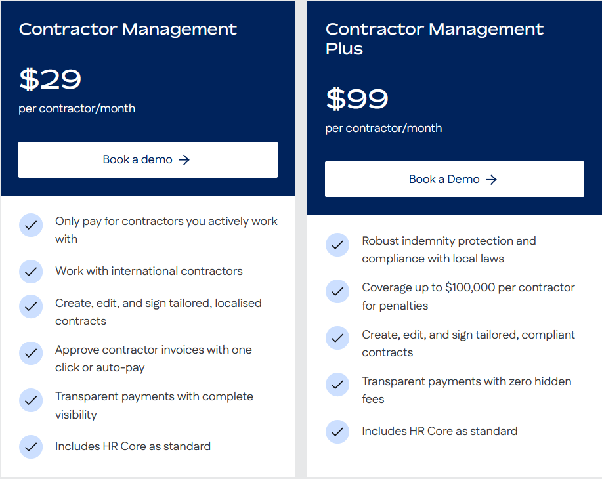
Caption: Remote offers two contractor plans - Contractor Management and Contractor Management Plus
It’s worth noting that contractors are not classified or managed under the same compliance guarantees as full-time employees—misclassification risk remains the client’s responsibility.
In the past, companies like Nike have been fined over $530m for misclassifying thousands of employees (Guardian). The risk of misclassification is too high for any business to bear.
3. Global payroll for entities
If you already have legal entities abroad and simply need payroll support, Remote offers a separate Global Payroll plan with $29 per employee/month pricing.
The payroll plans include international payroll management through a self-service platform, personalized support, benefits management, compliance management, and also Remote’s HR core as standard.
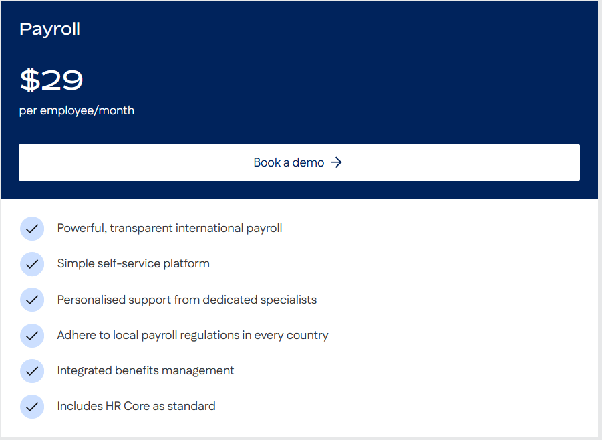
Caption: Remote offers global payroll at $29 per employee per month
4. Add-ons and optional modules
Remote markets a free tier called “Remote HRIS” that includes basic employee records, document storage, and time-off tracking. It comes for an additional cost of $12 per employee/month.
However, for features like integrations, reporting, or contractor benefits, you’ll need to upgrade to paid plans or request custom add-ons.
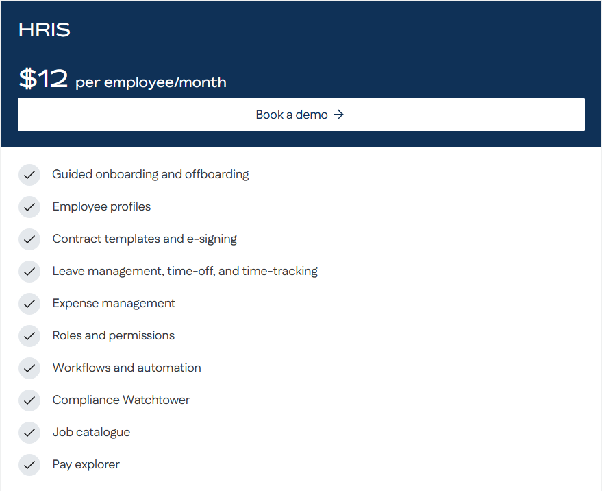
Caption: Remote markets a free tier called “Remote HRIS” that includes several additional HR management features
Add-ons and exclusions to watch for in Remote’s pricing
Remote promotes its $599/month EOR pricing as an all-in-one solution—but that flat fee only covers the basics. While it's true the core package includes compliant employment, local payroll, and onboarding support, many of the tools and services scaling teams need come at an additional cost.
Here’s a breakdown of what isn’t covered under the base plan:
| Feature |
Pricing Info |
Notes |
| Contractor benefits |
Starting $325 per contractor/month |
Optional insurance or perks for freelancers—not bundled into a base plan. |
| Supplemental benefits (non-statutory) |
Custom / Required in some countries |
Ex: meal vouchers, transportation, or retirement contributions. |
| Multi-country setup complexity |
No added fee, but practical costs may increase |
Time zone, legal, and HR coordination demands rise with scale. |
| Global Payroll (for your own entities) |
Quote-based, separate from EOR plan |
Remote charges per-country payroll fees outside of the EOR service. |
| Integrations & advanced HRIS tools |
Not part of “HRIS Core” (free), may require upgrade |
Integrations with systems like Workday, BambooHR, or ERP tools. |
| Immigration support (visas, permits) |
Not included |
No native visa sponsorship—must use a third-party partner. |
Caption: Add-ons and exclusions that are not part of Remote’s pricing
What does Remote’s pricing breakdown mean for your business?
Remote’s pricing is straightforward if you’re hiring one or two employees in markets with simple compliance rules. But as soon as you layer in more countries, contractors, or advanced reporting needs, the all-in-one simplicity gives way to a more modular (and potentially expensive) cost structure.
If you’re evaluating platforms for global expansion, this is the stage where many teams realize the difference between “included” support and “available” support.
Comparing Remote’s pricing to its competitors
Remote’s $599/month flat rate EOR fee is competitive—especially for companies looking to hire full-time employees in countries where Remote owns legal entities.
But price alone doesn’t tell the full story. When comparing Remote to other EOR providers, it’s important to weigh support quality, flexibility, legal coverage, and how pricing scales as your team grows.
Here’s how Remote stacks up against several well-known alternatives in 2025:
| Provider |
EOR Base Price |
Contractor Fee |
Support Model |
Notable Add-ons |
Pricing higher or lower to Rivermate |
| Remote |
$599/mo |
$29/mo |
Email/ticket-based |
Benefits, integrations, global payroll |
Higher pricing |
| Deel |
$599/mo |
$49/mo |
Chatbot + tickets |
Visa, fintech add-ons |
Higher pricing |
| Oyster |
From $499/mo |
$29/mo |
Email/ticket-based |
Country-specific benefits |
Higher pricing |
| Multiplier |
~$400–500/mo |
$40/mo |
Standard support |
Insurance, immigration |
Higher pricing |
| Rivermate |
€299/mo (~$325) |
Fixed |
Slack, WhatsApp, email |
All legal and onboarding included |
Significantly lower than Remote ‘s pricing |
Caption: Compared to other EOR platforms, Remote tends to be more expensive.
Remote offers a streamlined pricing experience—but only if your needs are equally streamlined. For startups or finance teams looking for predictable billing and white-glove support, platforms like Rivermate may deliver stronger ROI, especially as hiring complexity grows.
Pros & cons of Remote’s pricing model
| Pros |
Cons |
| flat rate EOR pricing ($599/mo) makes budgeting straightforward |
Limited flexibility for custom workflows or non-standard setups |
| No onboarding or setup fees |
Support is primarily ticket-based—not ideal for urgent issues |
| Owns legal entities in all supported countries |
Country-specific complexity not reflected in the flat fee |
| Bundles contractor and EOR services in one platform |
No immigration or visa services included |
| Public pricing available—no sales call required |
Contractor compliance responsibility stays with the client |
Caption: Table comparing the pros and cons of Remote’s flat rate EOR pricing
Should you rely on Remote’s flat rate?
Remote’s pricing model works well for companies hiring a few employees in straightforward markets. But if you’re hiring across multiple countries, need local legal advice, or want a more consultative partner, the costs—financial and operational—may add up faster than expected.
Six cost factors that may affect your real spend with Remote
Flat monthly pricing may seem straightforward—but it rarely tells the full story. When evaluating Remote (or any global employment platform), it’s essential to look beyond the headline rate and consider the total cost of ownership (TCO) across your hiring footprint.
Here are six key factors to help you assess what Remote will actually cost your business:
1. Hiring countries and benefit expectations
Remote charges the same EOR fee across all supported countries, but statutory and supplemental benefit costs vary widely. In some markets—like Germany or Brazil—mandatory benefits and bonuses can add 25–35% to base salary. These are billed separately, not bundled in the $599/month.
| 👉 Tip: If costs for add-ons are not provided directly, book a live demo and ask the support agent to stimulate actual costs for add-ons based on your requirements. |
2. Employee vs. contractor mix
While Remote supports both, their compliance models differ. You’ll pay $29/month per contractor, but the legal responsibility for classification stays with you—not Remote. If you misclassify a long-term or high-control contractor, the cost of fines or backpay can far outweigh the monthly savings.
| 👉 Tip: If your contractor engagement is recurring or location-specific, consider an EOR model or seek platforms (like Rivermate) that offer classification guardrails. |
3. Scale and complexity
The more countries you hire in, the more you’ll need coordination across time zones, languages, and employment laws. Remote’s fixed-rate model doesn’t scale support accordingly. If you’re hiring in 5+ countries, you may encounter platform limitations, slower response times, or the need for additional legal consultation.
| 👉 Tip: Ask what the average response time is for multi-country issues. Rivermate offers 15-minute response SLAs with local experts available via Slack or WhatsApp. |
Remote’s “HRIS Core” lacks integrations, reporting, or advanced workflow customization. If you want to connect Remote with your HRIS, accounting system, or ERP platform, you may need to upgrade or build workarounds—incurring extra costs or dev time.
| 👉 Tip: List your must-have integrations before shortlisting EORs. Ask if they're included, or if they require third-party tools or engineering lift. |
5. Currency conversion and invoicing fees
Remote bills in USD but pays employees and contractors in local currency. While FX fees aren’t always disclosed upfront, they can add up—especially if you’re operating in high-volatility markets.
| 👉 Tip: Clarify if Remote applies currency conversion fees or uses third-party processors. Platforms like Rivermate offer billing in EUR, GBP, or USD with no markup surprises. |
6. Support model and internal bandwidth
The biggest cost isn’t always financial—it’s time. If your internal HR or finance team spends hours chasing compliance answers, reconciling invoices, or managing escalations, the total cost of “self-service” becomes clear.
| 👉 Tip: Consider the cost of internal friction. Rivermate reduces this by giving every client a dedicated account manager and 24/7 access to real humans—not just help docs. |
Remote’s headline price is predictable—but your actual spend depends on how you use the platform. Before you commit, map your use case, expansion plans, and required support. Then calculate the full cost—not just the monthly rate.
Choosing the right EOR: pricing strategy
Choosing the right EOR isn’t just about finding the lowest monthly fee—it’s about finding a pricing model that matches your global hiring goals, operational capacity, and risk tolerance. While Remote’s $599/month flat rate can work for lean teams with simple needs, it may fall short for companies scaling into multiple regions or looking for high-touch support.
Here’s how to think strategically about EOR pricing before making a decision:
Match pricing to complexity—not headcount alone
Many platforms are priced by the number of employees, but complexity and not volume is what drives cost and effort. Hiring three people in Germany, Brazil, and India can require more legal support than hiring 10 in the UK. If your expansion plans include diverse legal jurisdictions or country-specific benefits, a flat rate may not reflect actual support needs.
Predictability vs. flexibility
Remote offers pricing predictability but trades off flexibility. You’ll get one rate but with limited customization. If your team needs visa support, market-specific benefits, or custom workflows for hiring approvals, a rigid platform could create internal blockers or force you to layer in additional tools.
Don’t underestimate support fatigue
A platform may seem cost-effective on paper but lead to internal frustration if your team struggles to get timely answers or escalate issues. Ticket-based systems often lead to context switching, missed deadlines, or legal blind spots.
Consider the long-term ROI
An EOR partner isn’t just a vendor—they influence the speed, safety, and clarity of your entire global hiring process. The right partner saves money by preventing misclassification, avoiding fines, and keeping your operations audit-ready.
Rivermate, for example, offers:
-
Fixed pricing with no onboarding or hidden fees
-
Legal-first onboarding, contract updates, and daily compliance monitoring
-
Local expertise in 150+ countries
-
Human support over Slack, WhatsApp, or email—backed by SLA
Conclusion
If you’re evaluating Remote against other providers, focus on cost transparency, support quality, and how the platform handles complexity. A few dollars saved on a monthly invoice can easily be outweighed by compliance issues, churn, or delays.
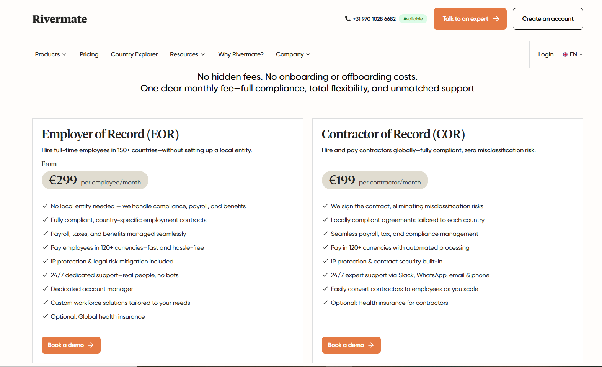
Book a free 30-minute consultation with a Rivermate expert!
FAQs
Does Remote require a minimum number of employees or contractors?
No, Remote does not require a minimum headcount. You can hire a single full-time employee or onboard one contractor through the platform. However, smaller teams may find less value in Remote’s flat pricing model compared to providers with flexible or volume-based plans.
Remote does not charge separate onboarding or setup fees for its Employer of Record (EOR) service. The $599/month rate includes onboarding, contract generation, and payroll setup for each employee. However, custom configurations or country-specific requirements may incur additional costs indirectly.
Can I expect to pay any additional fees with Remote?
Yes. While the EOR rate is fixed, companies may encounter added costs for:
-
Supplemental benefits (e.g., allowances, private health insurance)
-
Visa and immigration support (not included)
-
Currency conversion or cross-border payment fees
-
Contractor benefits or classification assistance
Is Remote more affordable than other solutions?
It depends on your needs. Remote offers a clear flat rate model, which is helpful for cost forecasting—but it may not be the most affordable for companies hiring across complex regions or seeking consultative support. Platforms like Rivermate offer fixed pricing nearly 50% lower, with personalized legal support and no add-on fees.
Which currencies does Remote support for billing?
Remote bills clients in USD only, regardless of where your team is located. Payments to employees and contractors are made in their local currency, often via third-party processors. FX fees and currency conversion rates may apply and are not always transparent upfront.
What’s the difference between HR Core and Remote HRIS?
HR Core is Remote’s free HRIS tool for managing basic employee records, time off, and document storage. It’s included in all plans. For advanced features like integrations, analytics, and automation, companies may need to upgrade or use external HRIS platforms.












